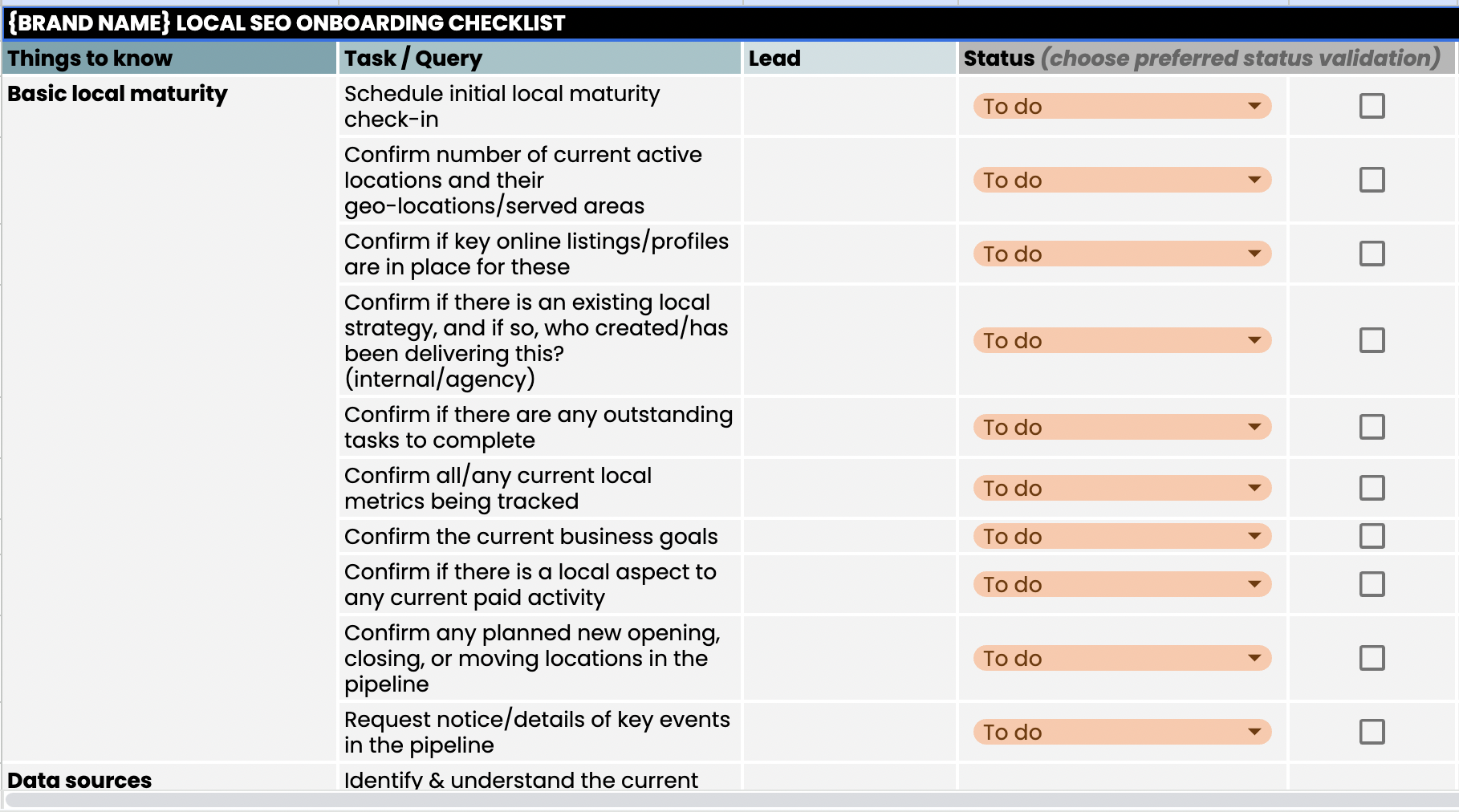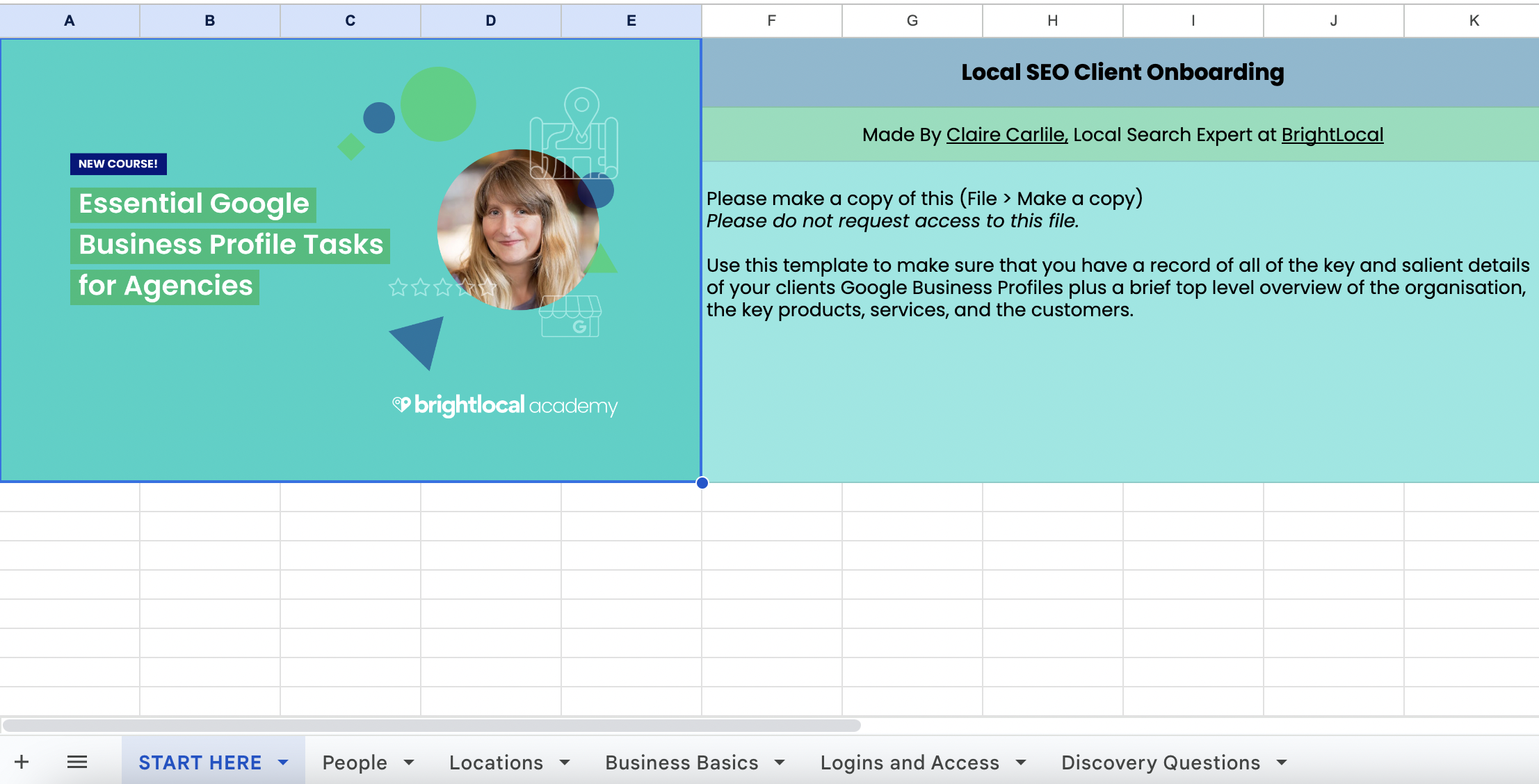This article is from our Agency Playbook—a collection of guides created to help local SEO agencies grow and succeed. It is chapter seven of ‘Part One: Pitching and Onboarding’.
Firstly, congratulations on a successful pitch!
It’s super exciting and rewarding to have won a new client, especially after a potentially long, competitive pitch process. But after the celebrations comes one of the final hurdles. Before getting down to the real business of starting to deliver on all the proposed implementations and optimizations that won you the pitch in the first place, the client needs to be officially onboarded.
While other teams will likely handle the contracts and compliance side of things, the individual, team, or project manager must set to work on the account. Having a robust, structured onboarding process to turn to at this stage can be crucial. Not only can it help ensure everyone is on the same page from the get-go, but it can also help deliver better results and build stronger relationships.
This is when a ready-to-go onboarding checklist can be your best friend, helping your team avoid common early missteps and hit the ground running.
Preparation and Creating Your Client Onboarding Checklist
A checklist certainly doesn’t need to be anything too technical or fancy; a simple Excel or Google sheet can work well, which is usually my preference! But what should it include?
In a nutshell, the checklist should help identify all the initial conversations and information gathering that’s needed, all the tools and platforms you will need access to, plus the typical kick-start tasks that help you identify key opportunities and the general lay of the local digital landscape for your new client.
In simpler terms, a typical local SEO onboarding checklist can be divided into three main sections:
- Things we need to know
- Things we need to access
- Things we need to do
Individual tasks or actions generally fall under these three buckets and can be added as separate checklist lines. A suitable status indicator should also be included. This could be a formatted drop-down menu offering a choice of progress statuses or as simple as a checkbox. Who doesn’t love the satisfaction gained from a successful tick?
Try a Free Local SEO Onboarding Checklist Template Croud has put together a local SEO onboarding checklist template. To use it, follow the link below, click the ‘Make a copy’ button, and rename it accordingly.
Croud has put together a local SEO onboarding checklist template. To use it, follow the link below, click the ‘Make a copy’ button, and rename it accordingly.
1. Things We Need to Know
To kick off, a checklist should cover essential information gathering that’s needed to provide helpful new account context so that we can:
- Tailor our strategy accordingly
- Set realistic goals and expectations
- Identify any challenges and opportunities
- Set the bar for collaboration and communication
- Start strong
Every client will be different, with their own needs and nuances, so while the following checklist recommendations are by no means exhaustive, they should cover the most common bases:
Perform a Basic Local Maturity Check-In
A key first step is to arrange an initial meeting with the client to discuss their current local SEO setup and what will be needed to create and deliver the best strategy moving forward. Having a basic set of questions ready to ask and collating detailed answers will help inform those first important strategy steps. This is often called the discovery phase.
Some of this information may already be known from the pitch process, as covered in RFPs or brief details. If not already shared with you, asking for details on past or current local search strategies, including any metrics and local business goals, is a great starting point. Knowing that driving physical footfall into stores is the priority over increasing website clicks or that key stakeholders are very focused on the brand’s reputation across certain locations, for example, will help frame your initial roadmap.
It will also be key to confirm if you will be starting from scratch with a clean slate or taking over from an existing strategy or agency where there is still work to complete. The client may already have a well-established brand with a local SEO foundation in place, but they need fresh eyes and ideas to turn declining performance around.
Alternatively, if the client is a relatively new business that has initially focused on launching its website, it may still need the basics set up for local SEO, such as creating Google Business Profiles or providing recommendations for potential location pages .
Whatever has come before, it’s important to understand how the client views their current local maturity and success. The checklist can note this context, which will help prioritize the initial focus areas and set realistic goals for the short, medium, and long term.
Tip: It can also be helpful to briefly check the client’s paid activity to get a top-line view of any planned strategy, especially if it is focused on local campaigns.
Create a Centralized Data Source
Any local SEO strategy will undoubtedly require access to and understanding of a brand’s key local business information, whether for brick-and-mortar locations such as stores or offices or the geographical areas the business serves.
For example, it will be difficult to audit Google Business Profiles without knowing accurate location names, addresses, and phone numbers to validate accuracy.
Therefore, it’s important early on to determine where the core information about each physical location or targeted service area is stored and what they consider their source of truth. This could be an internal database or digital repository, an Excel file, or a tool like BrightLocal!
Local Market Analysis & Research
You’ll likely have conducted local market research and analysis in preparation for the pitch process. However, this may have been a diluted or narrow view, such as looking at a single market. As part of onboarding, building this out for a more complete picture early on is important. This will likely include the following info-gathering tasks to add to your checklist:
- Competitor analysis: Identify local competitors through helpful tools or review search results for relevant keywords. Then, review their local SEO set-up to benchmark maturity and inform the direction of the strategy.
- Target audience: Use a combination of analytics tools and client feedback to understand the current customer demographic and any opportunities to appeal to a wider or different audience.
- Targeted local keywords: Identify relevant local keywords that existing and potential customers may use to find your new client’s products or services. Tools such as Google Keyword Planner, SEMrush, or Ahrefs can be helpful here.
Tip: Who the client perceives as their local competitors may not always align with who their actual competitors are . Identifying their true rivals in the local SERP and presenting this information may influence your strategy or re-establish previous goals.
Tools like GBP Audit and Local Search Grid are fantastic for this.
Client Contacts
It likely goes without saying, but it’s essential to determine who the main day-to-day client contacts will be and any other key stakeholders you may meet or report to. It’s important to note that with local SEO, you may need to collaborate with individuals from across a range of brand teams, including website, marketing, sales, stores/retail, or social media. We’ve seen much collaborative success at Croud from identifying and connecting with these additional teams early on in the local onboarding process.
For a multi-location business or a franchise, you may also be working with specific regions or branches. So, it’s worth clarifying early on who your key contacts are.
Tip: Create a contact log for future reference, and reciprocate by sharing a contact log from your side with the client!
Define Ways of Working
You can be brimming with local SEO knowledge and skills and raring to implement an exciting strategy for your new client, but it’s crucial to take the time to understand how they prefer to work, communicate, and collaborate.
Be sure to ask about the project management tools and communication channels they may already use and feel comfortable with and be willing to adopt these methods. This can instantly help build rapport, show you value their comfort and existing ways of working, and allow you to onboard more cohesively.
Sure, your agency may exclusively use Hangouts and the Google ecosystem, but if your client is deeply embedded in Microsoft, you may need to consider how that affects you. Suggesting a collaborative Slack channel may sound like a great idea, but it could add more hurdles if your client doesn’t have Slack.
Tip: Though the client’s preferences should be prioritized, and you may need to adapt, don’t be afraid to make suggestions for change. Provide informed choices, especially where you have experience to share.
2. Things We Need to Access
To efficiently run audits, implement optimizations, troubleshoot issues, plan local content creation, set up benchmarking, and conduct robust reporting, you will need access to various tools and platforms and visibility of key brand assets. Additionally, being well set up to quickly gain insights and demonstrate optimization or algorithm impact in a timely manner is also something to get ticked off early in the onboarding process.
- Google Business Profiles (GBP) : Key for all local activity, access to the client’s GBP locations will enable you to review their status, audit and update key business information, manage reviews and pull insights.
- Local listings : These may vary depending on the industry, but key platform listings and directories include Apple Business Connect, Bing Places for Business, Yelp, TrustPilot, and TripAdvisor.
- Social accounts: If supporting with social is in scope, e.g., Facebook, TikTok, Instagram, etc.
- SEO tools & platforms : It’s likely your agency has access to various SEO tools and platforms designed to track keyword rankings & performance, such as STAT, so it’s important to set up new client data ASAP. Additionally, if the client uses a listings management tool to maintain their online profiles and listings, having visibility is key e.g. BrightLocal, Uberall, Moz, Yext SOCi, etc.
- Analytics : This will help inform various performance reporting and analysis, such as Google Search Console, Google Analytics, Bing Webmaster, etc.
- Project management and communication tools: Depending on the client’s preferred ways of working, these could be task management and workflow tracking tools such as Asana and JIRA or communication and collaboration tools such as Microsoft Teams or Slack.
- Brand assets and guidance: These may be provided to you by the client or may be accessed via online repositories such as asset libraries containing photos, logos, brand and tone of voice guidelines, etc. Having access to these will help create consistent and appealing content.
3. Things We Need to Do
While a comprehensive local strategy and roadmap will include many tasks, and the immediate ‘things to do’ will vary from client to client, there are a few key common activities to prioritize from the start:
Conduct Local Keyword Research
You may have identified targeted keywords as part of your initial research and analysis, but expanding this to a full local keyword research project or refreshing a current KWR will help reveal untapped keyword opportunities that could inform local content plans.
Citation/Backlink Audit
Analyzing the client’s current backlink profile will highlight current strengths and weaknesses while reviewing the backlinks earned by competitors to help identify new opportunities for your client.
Key Listings & Local On-Page Audit
How effectively your client’s business locations and service areas are surfaced and perceived online underpins any successful local SEO strategy, not only to rank well for relevant keywords but also to serve correct, consistent, and helpful information to potential local customers, that ultimately converts.
Early on, a key action with a new client will be to audit and review existing online business profiles and listings for accuracy and completeness. Conduct an audit of key listings, starting with Google Business Profiles, to ensure they are eligible to surface (are verified and live) and are fully optimized.
When reviewing Google Business Profiles, it’s important to note the page each profile is pointing to, and what that page is telling Google about the business, its location, and its offering. Conducting an audit of these pages (often location service or store pages) can be just as key as auditing Google Profiles themselves, and may highlight some great on-page opportunities that can be built into the local strategy.
Reputation Review
I like to include an initial overview of a brand’s online reputation to determine whether there are any red flags to be aware of or quick wins to be had. Though this may not be an initial focus for all new clients, it’s crucial for local visibility and customer conversion.
You could add a checklist action to assess existing reviews across publishers such as Google, Facebook, Yelp, Trustpilot, and any other relevant reputation platforms to understand how the brand and its locations are currently perceived vs their competition.
Initial Local SEO Strategy Roadmap
Lastly, make sure to include an initial strategy plan creation in your checklist so you can conclude your onboarding plan by sharing a first draft plan of action with your new client for their review, feedback, and approval. This could be approached in several ways but could cover the first 3, 6, and 12 months or be segmented into proposed quick wins, incremental gains, and big bet projects.
Presenting a ready-to-move strategy early on sets a strong tone. This should certainly seek to align with expectations set during the pitch process but should be open to evolving based on onboarding conversations, client feedback, and emerging trends.
Final Thoughts
A methodical and organized onboarding process is essential for success in a local search strategy. When aided by a clear and efficient onboarding checklist, delays and potential blockers are reduced, leaving you fully prepped and energized to sail smoothly into your first tasks!
Key Takeaways:
- A structured onboarding process helps avoid common challenges and blockers.
- Organize your checklist into things to know, things to access, and things to do for better clarity.
- Understanding the client’s local maturity, key contacts, and data sources is crucial.
- Gaining early access to SEO tools, platforms, and listings and conducting initial audits sets you on the right path.
Onboarding a local SEO client doesn’t have to be overwhelming, and by following a checklist can ensure a smooth process that sets you and your client up for success.




